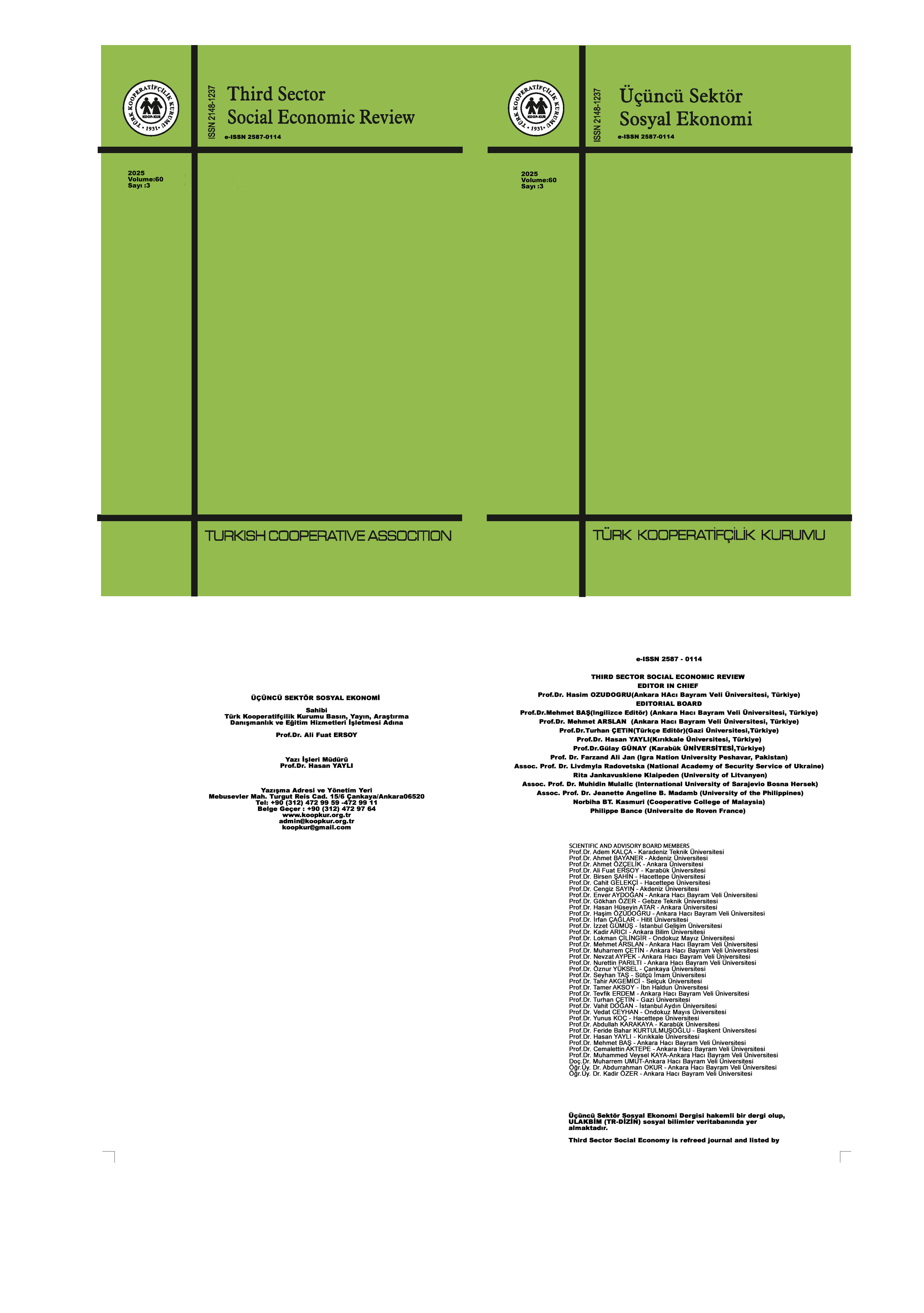Trends in Housing Research in Türkiye: A Bibliometric Analysis
DOI:
https://doi.org/10.63556/tisej.2025.1579Keywords:
Housing, Real Estate, Bibliometric Analysis, Prisma, MAXQDA-24Abstract
Housing is not merely a physical structure that meets individuals’ shelter needs; it is also a fundamental component in ensuring social justice, building societal welfare, and promoting sustainable urbanization. Increasing population, urbanization pressure, economic fluctuations, and disaster risks have rendered the housing issue a multidimensional and high-priority policy area. However, it is observed that systematic evaluations of academic production in the field of housing in Türkiye remain limited. Therefore, this study aims to map the existing literature and identify future research areas by conducting a bibliometric analysis of master’s and doctoral theses written between 1986 and 2025 in Türkiye. A total of housing keyword-based 1,997 theses obtained from the Council of Higher Education Thesis Center database were analyzed according to various criteria such as thesis title, subject area, academic discipline, institution, and year of production. The analysis conducted using MAXQDA-24 software reveals that the majority of studies are concentrated in architecture and interior architecture disciplines. Although housing studies exhibit a multidisciplinary character, the need for increased research on sustainability, the right to housing, disaster risk, and social inclusion is emphasized. This study aims to guide future interdisciplinary research in areas such as disadvantaged groups, housing accessibility, and green building practices, while also offering evidence-based insights to inform policy-making processes.
References
Alkan, L., & Uğurlar, A. (2015). Türkiye’de konut sorunu ve konut politikalari. Kent Arastirmalari Enstitüsü, Rapor, 1.
Balaban, O. (2012). The negative effects of construction boom on urban planning and environment in Turkey: Unraveling the role of the public sector. Habitat International, 36(1); 26-35.
Çoban, A.N. (2012). Cumhuriyetin ilanından günümüze konut politikası. Ankara Üniversitesi SBF Dergisi, 67(03); 75-108.
Donthu, N., Kumar, S., Mukherjee, D., Pandey, N., & Lim, W. M. (2021). How to conduct a bibliometric analysis: An overview and guidelines. Journal of Business Research, 133, 285-296. https://doi.org/10.1016/j.jbusres.2021.04.070
Ellegaard, O., & Wallin, J. A. (2015). The bibliometric analysis of scholarly production: How great is the impact? Scientometrics, 105, 1809-1831. https://doi.org/10.1007/s11192-015-1645-z
Efe, S., Yıldızan, A. P., & Kiriş, H. M. (2024). Türkiye’de kentsel dönüşümü yeniden düşünmek: 2023 tarihli 7471 sayılı yasal düzenleme ve öngörüler. Çağdaş Yerel Yönetimler, 33(3), 39-68.
Ersoy, M. (2020). Osmanlıdan Günümüze İmar ve Yasalar, Ninova Yayınları, İstanbul.
Gök, S. F. (2010). Konut ediniminde kullanıcı kararlarını etkileyen faktörler; İstanbul ili toplu konut projeleri örneği (Master's thesis, Mühendislik ve Fen Bilimleri Enstitüsü).
Görün, M., & Kara, M. (2010). Kentsel dönüşüm ve sosyal girişimcilik bağlamında Türkiye’de kentsel yaşam kalitesinin artırılması. Yönetim Bilimleri Dergisi, 8(2), 137-164.
Gyourko, J. (2009). Housing supply. Annu. Rev. Econ., 1(1), 295-318.
Hatipoğlu, Ü., & Tanrıvermiş, H. (2017). Türkiye’de arz ve talep açısından konut yatırım tercihlerini etkileyen faktörlerin değerlendirilmesi. Bankacılar Dergisi, 100, 49-75.
Keleş, R. (2013). Kentleşme Politikası (güncellenmiş 13. baskı). İmge Kitabevi: Ankara.
Kıray, M. (1998). Gecekondular. Kentleşme yazıları içinde (ss. 19-27), Bağlam Yayıncılık, İstanbul.
King, P. (2006). Choice and the end of social housing institute of economic affairs . Hobart Paper 155. IEA. London.
Kuckartz, U., & Rädiker, S. (2019). Analyzing qualitative data with MAXQDA. Springer International Publishing.
Kutsal, S., & Polatoğlu, Ç. (2023). Türkiye’de artan konut ihtiyacı ve konut sorununun dinamikleri. Topkapı Sosyal Bilimler Dergisi, 2(1), 133-158.
Lebe, F., & Akbaş, Y. (2014). Türkiye’nin konut talebinin analizi: 1970-2011. Atatürk üniversitesi iktisadi ve idari bilimler dergisi, 28(1), 57-83.
Moher, D., Liberati, A., Tetzlaff, J., Altman, D. G., & Prisma Group. (2010). Preferred reporting items for systematic reviews and meta-analyses: the PRISMA statement. International journal of surgery, 8(5), 336-341.
Mutlu, S. (2007). Türkiyede yaşanan gecekondulaşma süreci ve çözüm arayışları: Ankara örneği (Master's thesis, Sosyal Bilimler Enstitüsü).
Ören, K., & Yüksel, H. (2013). Türkiye’de konut sorunu ve temel dinamikleri. Süleyman Demirel Üniversitesi Sosyal Bilimler Enstitüsü Dergisi, (18), 47-84.
Page, M. J., McKenzie, J. E., Bossuyt, P. M., Boutron, I., Hoffmann, T. C., Mulrow, C. D., ... & Moher, D. (2021). The PRISMA 2020 statement: an updated guideline for reporting systematic reviews. bmj, 372.
Rizzo, A., Aquilina, R., & Falzon, R. (2024). Applying MAXQDA in a grounded theory study: Evaluation. Computer Supported Qualitative Research: New Trends in Qualitative Research (WCQR2024), 1061, 175.
Sayan, M. C. (2002). Ankarada yeni yerleşim alanlarındaki uygulamaların peyzaj tasarım ilkeleri açısından irdelenmesi (Master's thesis, Fen Bilimleri Enstitüsü).
Şimşek, Z.Y. (2024). Dünyada ve Türkiye’de Konut Sorunu ve Uygulanan Konut Politikaları. Uluslararası Akademik Birikim Dergisi, 7(2); 112-132.
Tanrıvermiş, H. (2019). Türkiye ekonomisinde inşaat ve gayrimenkul sektörlerinin rolleri ve gelişme eğilimlerinin değerlendirilmesi. Kent, İnşaat ve Ekonomi Kongresi, Gaziantep, 36-57.
Tanyanyiwa, V. I., & Kanyepi, T. (2021). Shanty towns: a solution to housing shortage problems. In No Poverty (pp. 925-936). Cham: Springer International Publishing.
Tekeli, İ. (1991). Kent planlaması konuşmaları. TMMOB Mimarlar Odası.
Yolcu, F. (2021). Türkiye’de kentsel dönüşümün yasalar ve aktörler üzerinden dönemsel olarak değerlendirilmesi. Planlama Dergisi, 31(3); 393-401.
Downloads
Published
How to Cite
Issue
Section
License
Copyright (c) 2025 Third Sector Social Economic Review

This work is licensed under a Creative Commons Attribution-NonCommercial 4.0 International License.







